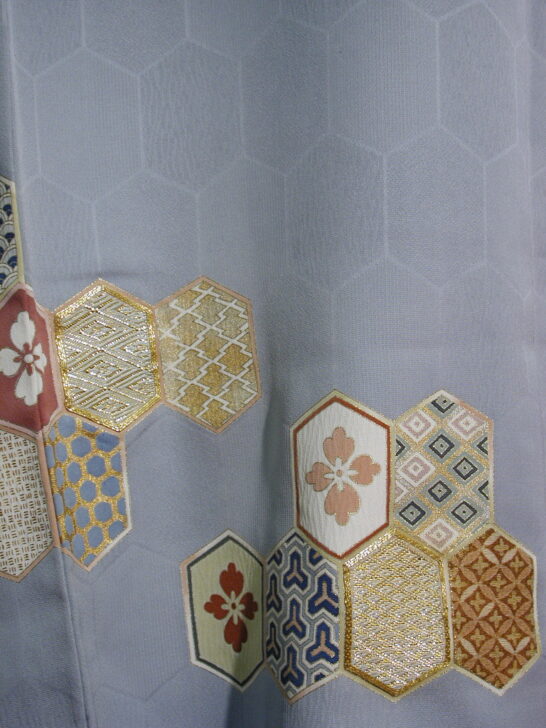Light blue crested kimono with woven hexagonal pattern, enhanced by painted and gilded designs and appliquéd Saga brocade.
Japanese

Description
Kimono
Japan, Showa period (1926–1989)
circa 1970–1979
Silk crepe with painted, gilt, and embroidered designs
Gift of Howard and Patricia Yamaguchi, 2005/1.391
Although the majority of Japanese brocade—a rich fabric with a raised design, woven with gold and silver threads—is produced in the Nishijin district of Kyoto, certain types are made in former castle towns like Saga and Kaga. Saga brocade, still renowned today, originated as a textile art practiced as a pastime in the Edo period (1615–1868) by the ladies-in-waiting of the ruling Nabeshima clan of the Kashima domain (modern-day Saga prefecture in the southwestern island of Kyûshû). Saga brocade is produced by hand on a small, lap-sized table, using thin gold, silver, and platinum papers for the warp, and colorful silk threads for the weft. Because of the delicate, painstaking nature of the process, only a tiny amount can be woven in one day. Therefore Saga brocade is usually restricted to small pieces of appliqué, as in these examples.
Gallery Rotation Spring/Summer 2012
Subject Matter:
Although the majority of Japanese brocade—a rich fabric with a raised design, woven with gold and silver threads—is produced in the Nishijin district of Kyoto, certain brocades are made in former castle towns like Saga and Kaga. Saga brocade, still renowned today, originated as a textile art practiced as a pastime in the Edo period (1615–1868) by the ladies-in-waiting of the ruling Nabeshima clan of the Kashima domain (modern-day Saga prefecture in the southwestern island of Ky?sh?). It is hand produced on a small, lap-sized table, using thin gold, silver, and platinum papers for the warp, and colorful silk threads for the weft. Because of the delicate, painstaking nature of the process, only a tiny amount can be woven in one day. Saga brocade, therefore, is usually restricted to appliqués, as in these examples.
Physical Description:
Silk crepe with yûzen (painted) and surihaku (gold foil) designs and appliquéd patches of Saga brocade, all in hexagonal shapes to match the damask weave of the ground cloth.
Usage Rights:
If you are interested in using an image for a publication, please visit https://umma.umich.edu/request-image/ for more information and to fill out the online Image Rights and Reproductions Request Form.